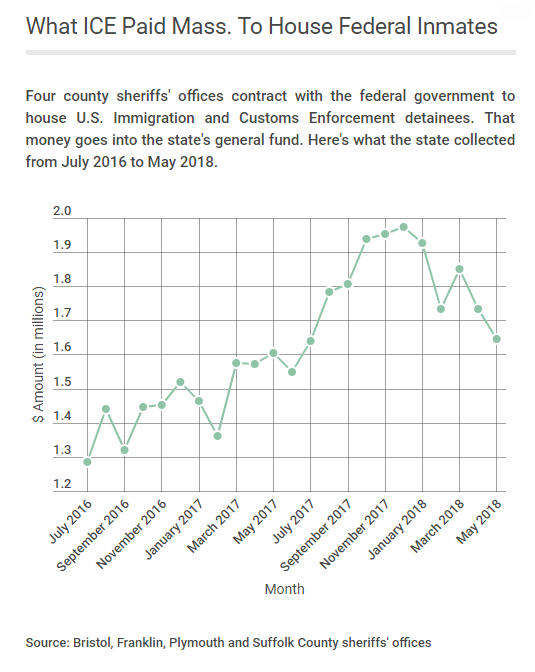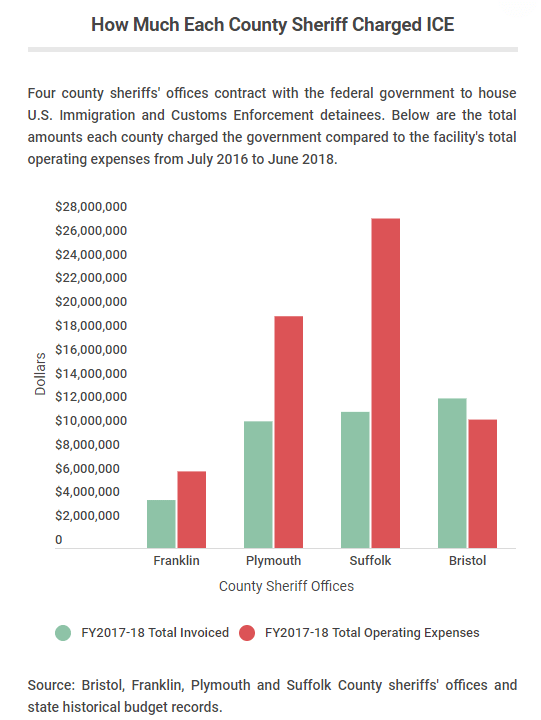Advertisement
County Jails Bring Millions Of Dollars To Mass. By Housing ICE Detainees
Resume
Many Massachusetts towns and cities have been pushing back against President Trump's crackdown on immigration since he was elected. A growing number have established sanctuary policies, and groups have called on local universities to end contracts with U.S. Immigration and Customs Enforcement (ICE).
Against this highly-charged political backdrop, Massachusetts sheriffs continue to house ICE detainees in their jails for the federal government. It's a longstanding practice that brings millions of dollars into the state.
County By County
Bristol, Franklin, Plymouth and Suffolk County sheriffs' offices each hold contracts with the federal government to house ICE detainees in their respective facilities. Suffolk County's contract dates back to 2003.
These are county jails that normally hold state inmates serving short sentences or awaiting trial. ICE detainees housed at these jails could be undocumented immigrants who have no criminal charges but are in removal procedures — that means the government is trying to deport them. Or, they could be immigrant detainees with criminal records who are also awaiting deportation.
The sheriffs charge the federal government for the services associated with holding ICE detainees. Those services include housing, transportation and, in some cases, medical care and office space rental. That money goes to the state's general fund — a large pool of money that funds everything from education to transportation.
WBUR requested copies of housing contracts as well as invoices charged by the county sheriffs' offices to the federal government during the past two fiscal years.
Here's what we found:

In fiscal years 2018 and 2017 combined, the four sheriffs' offices brought nearly $40 million into the state's general fund.
'I'm Not Sure If We Are Making Money Off The ICE Detainees'
Determining whether the state profits off of these housing contracts with ICE is a complicated pursuit.
In a series of public records requests, WBUR asked the four sheriffs' offices for the daily bed rate charged per ICE detainee. Those fees range from a high of $98 a day per ICE detainee at Bristol County to a low of $90 a day per detainee at Suffolk County.
WBUR also requested estimated daily costs associated with housing those same inmates. The Bristol County sheriff's office was the only county to provide daily average costs per inmate. Sheriff Thomas Hodgson said, on average, it costs $88 a day to house an inmate. That's compared to the $98 a day the sheriff's office charges ICE per detainee. When asked what happens to the $10 difference, Hodgson deferred to the state.
"We're more interested in making sure that whatever monies are coming in, that our costs are covered, and that if there's any additional monies that it's reinvested either in infrastructure upgrades or things like that — but we don't control it anymore, the state does," he said.
The other three sheriffs' offices responded saying they either didn't track that number or didn't have corresponding records.
State Rep. Antonio Cabral of New Bedford, which falls in Bristol County, said he'd welcome more insight into whether the state sees any net profits as a result of these contracts with ICE.
"I'm not sure if we are making money off the ICE detainees," Cabral said. "It actually would be a good analysis. It's one that I have never been able to see — an analysis of how much it costs to provide the service to each detainee and does the $90, or $99, cover that cost."
As of 2016, the money invoiced to ICE was rerouted away from the individual sheriffs' offices and into the state's general fund.
The Executive Office for Administration and Finance did not address the question of profit.

Trends Among The Counties
In September 2017, the four sheriffs charged ICE a combined 37 percent more that month over the previous year — which suggests the facilities housed more ICE detainees.
At Plymouth County, the total charged to ICE spiked in February 2018. The jail charged the federal government 154 percent more that month than it did the prior year.
John Birtwell, a spokesman for the Plymouth County Sheriff's Office, said that big an increase simply reflects the fact ICE requested more beds.
"As we do not determine when [an ICE detainee] arrives or leaves, we would have no way of knowing what circumstances the federal officials may have faced elsewhere in the system," Birtwell said in an email. "I suppose if Suffolk or other facilities in the region had bumps in their capacity, we might get an influx — but that's just a hunch."
ICE spokesperson John Mohan said in an email that when determining where ICE detainees are placed, "there are multiple factors taken into consideration including the availability of beds at a particular facility in addition to other factors. The numbers of detainees housed at different locations are a fluid number and do typically fluctuate from month to month, or year to year; there is no one factor that alone determines this number."
These increases came within the larger context of statewide declines in overall inmate populations. According to a report released last year by MassINC, a research and policy nonprofit, correctional facilities in the state have seen a 21 percent drop in populations over the last seven years.
Ben Forman, research director at MassINC, said despite these declines, overall spending for correctional facilities, including county sheriffs' offices, has increased.
"As our populations have declined in our correctional facilities, there's been beds to fill in order keep people employed. One of the questions for us is, would we rather close these facilities and find other employment for these correctional officers?"
Or, Forman said, keep filling these empty beds with ICE detainees.
The Baker administration's fiscal year 2020 budget proposal funds county sheriffs' departments at a total of $643 million — a $70 million increase over fiscal year 2019 appropriations.
WBUR's Ally Jarmanning contributed data analysis to this report
This segment aired on January 30, 2019.
